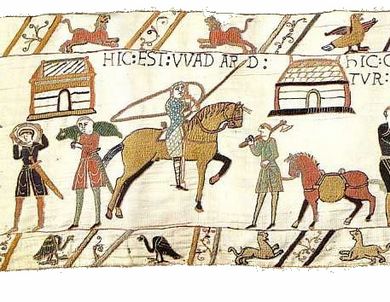Wadard facts for kids

Wadard was an important Norman nobleman from the 11th century. He traveled to England with William the Conqueror in 1066. Wadard is even shown and named in the famous Bayeux Tapestry. This tapestry tells the story of the Norman conquest of England. He is also mentioned in the Domesday Book of 1086, which was a huge survey of England.
Who Was Wadard?
Wadard was a noble who joined Duke William of Normandy on his journey to England in 1066. He was part of the Norman army that invaded England. The Bayeux Tapestry shows him during a trip to find food for the army. This suggests he might have helped with getting supplies. His picture in the tapestry also makes it seem like he was a high-ranking officer.
Wadard's Lands and Wealth
By the year 1086, Wadard had become a tenant of Odo, bishop of Bayeux. This means he rented land from Bishop Odo. Wadard held a lot of land, about 1,260 acres, in places like Kent and Oxfordshire. From these lands, he earned a good income of about £127 each year.
His properties included:
- Farming areas like Farningham and Combe in Kent.
- Six houses in the town of Dover.
- Lands in Cassington, Thrupp, Cogges, and Little Tew in Oxfordshire.
- An estate in Thames Ditton in Surrey.
- Land in Glentham in Lincolnshire.
Other Connections
A writer from the 14th century, William Thorne, wrote about Wadard. He said that the Abbot of St Augustine's Abbey gave Wadard some land for his lifetime. Wadard had to pay 30 shillings every year for this land. He also had to give a tenth of everything he earned from it. Wadard also witnessed a land gift to the Préaux Abbey in Normandy. He was also a tenant of St Augustine's Abbey.
Wadard's Family
Wadard had several sons who are mentioned in old records.
- His son, Rainald, also held two estates from Bishop Odo. These were at Somerton and Fritwell. These lands were next to his father's estate at Fringford.
- Two other sons, named Martin and Simon, are mentioned in the records of the Abbey of Préaux.

